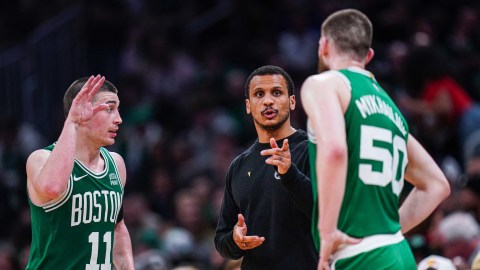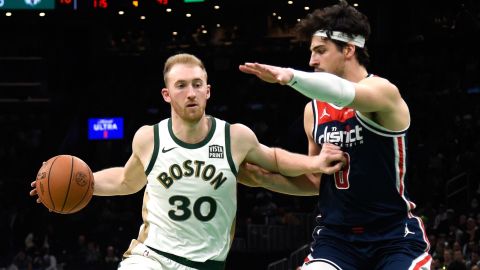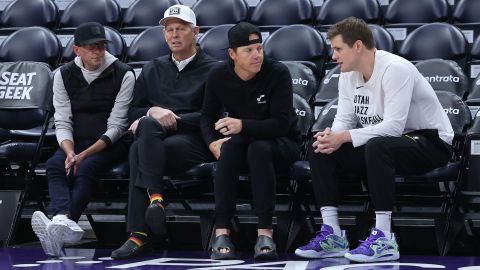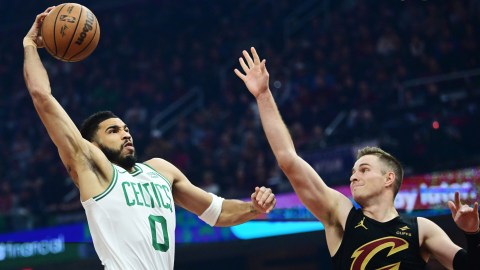 BOSTON — So often this season, Gerald Wallace has sat at his locker after games and talked about what “good teams” do. Most of the time, he hasn’t been saying it in reference to the Boston Celtics.
BOSTON — So often this season, Gerald Wallace has sat at his locker after games and talked about what “good teams” do. Most of the time, he hasn’t been saying it in reference to the Boston Celtics.
On Sunday, Wallace was relegated once again to admiring the way his opponent does business. After the Celtics spent most of a 102-91 loss to the Dallas Mavericks shooting below 30 percent from the field, Wallace explained what doomed his team. Shockingly, yet accurately, he did not point his finger at the Celtics’ poor shooting.
“The third quarter,” Wallace said. “Veteran teams put you out in the first five minutes of the third quarter. They came out attacking us and put us on our heels.”
The Celtics (18-34) were trounced by the Mavericks (31-21) in the opening minutes of the second half, to the tune of an 18-7 run to turn a six-point creek into an 18-point gulf. The Mavs would run their lead to as many as 24 points in the fourth quarter, cruising to an 11-point win with Dirk Nowitzki, who totaled 20 points in the game, scoring just five points in the final 24 minutes.
Celtics coach Brad Stevens claimed he was optimistic at halftime, which was strange, since his team entered intermission shooting just 27 percent from the field. But Stevens wasn’t frustrated with his team for missing shots. He figured that would turn around. He wasn’t entirely wrong, but he wasn’t right, either.
“We felt, at halftime, as a coaching staff, that we were in really good shape because we had shot 27 percent,” Stevens said. “We had guarded them very effectively, we had played at a very good rate, we just didn’t make shots. That happens sometimes, and you can live with that. But the third quarter and the start of the fourth killed us. They took us out of the game, and it really wasn’t as much about making shots or not making shots.”
What happened in the third quarter, then? As Stevens alluded, it wasn’t about missing shots; the Celtics actually made a better percentage in the third quarter (37 percent) than they had in the first half. Instead, they were decimated on the glass, getting outrebounded 17-6 and giving up seven offensive boards to the Mavs. Dallas dominated points in the paint 12-4 and second-chance points 9-0 in the frame.
A lot has been made of the Celtics’ third-quarter swoons this season, pointing to the post-halftime droughts as a culprit in Boston’s struggles. That’s probably misstating the connection. The third quarters aren’t a cause, just a symptom. Good teams own the third quarter — and the Celtics are not a good team.
Switcheroo
Six different players have started in Boston’s backcourt this season. That’s a half-dozen bodies for two spots, manned by everyone from an All-Star to a former power forward. Guessing who will be in the backcourt when the ball goes up has been almost as tough as predicting how Jeff Green will play on any given night. (Almost. Nothing is tougher than reading Green.)
Rajon Rondo and Avery Bradley were back in their respective point guard and shooting guard spots on Sunday. They were an improvement over Jordan Crawford, Phil Pressey, Green and Wallace, but they didn’t provide much in the way of substantive production. Rondo had 15 points, 12 assists and eight rebounds, but those numbers were mostly empty in the blowout defeat. Bradley shot 2-for-13 from the field and sat out the final 18 minutes, 41 seconds.
The constantly shifting backcourt has forced the Celtics to alter their style from game to game, which may contribute to the team’s troubles. Any team could have trouble readjusting itself every night, never mind one as young as Boston. Wallace, who has started in a hybrid two/three role alongside Green 10 times this season, expanded on that after Sunday’s game.
“I’ve always been a person where, you get one system and you stick with it regardless of who you’re playing,” Wallace said. “It’s like, ‘This is our thing.’ In order to be good as a team, we’ve got to perfect what we’re good at. Switching it up for opposing teams, that helps them out, because now we’re changing this up to guard this team, and we’re not used to playing that way. We should make teams adjust to us.”
Baby Dirk?
In body frame and playing style, Kelly Olynyk and Nowitzki are like mirror images, if the mirror is foggy enough. So far, the Celtics rookie’s production has yet to mirror the former NBA Finals Most Valuable Player’s, but that doesn’t keep Olynyk from aiming high.
“He’s a great guy for a lot of people to look up to,” Olynyk said before matching up with Nowitzki. “He’s a perennial All-Star, NBA champion, international player, all that kind of stuff. He’s really skilled in many different facets of the game — a big-time player.”
Olynyk started following Nowitzki when Steve Nash, a fellow Canadian, was a teammate of Nowitzki’s in Dallas. As much home-nation pride as Olynyk had with Nash, the 7-foot, 245-pound Nowitzki was much more similar to Olynyk from a physical standpoint. As Olynyk grew, it became much easier to emulate Nowitzki’s style than the darting, dashing exploits of Nash.
The comparisons can only go so far now. Stevens noted that Olynyk and Nowitzki both wear No. 41 on their jerseys, but the similarities largely end there. The Celtics envision Olynyk as a big man whose shooting ability can stretch a defense, but so far Olynyk has shied away from taking even the most wide-open shots. Nowitzki is also tough to double-team because of his passing ability, something Olynyk is still honing at the NBA level.
Their differences were on display once the ball went live. Nowitzki needed 16 shots to get his 20 points on Sunday. Olynyk took seven shots and scored just six, in a very un-Dirk-ian performance.
Have a question for Ben Watanabe? Send it to him via Twitter at @BenjeeBallgame or sent it here.



